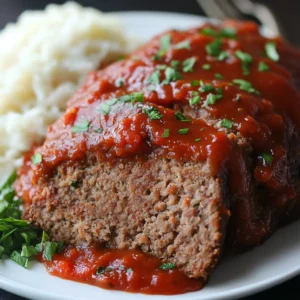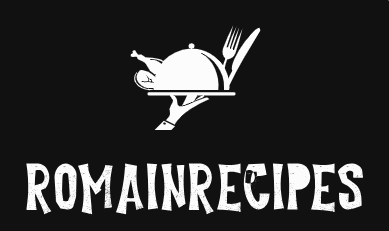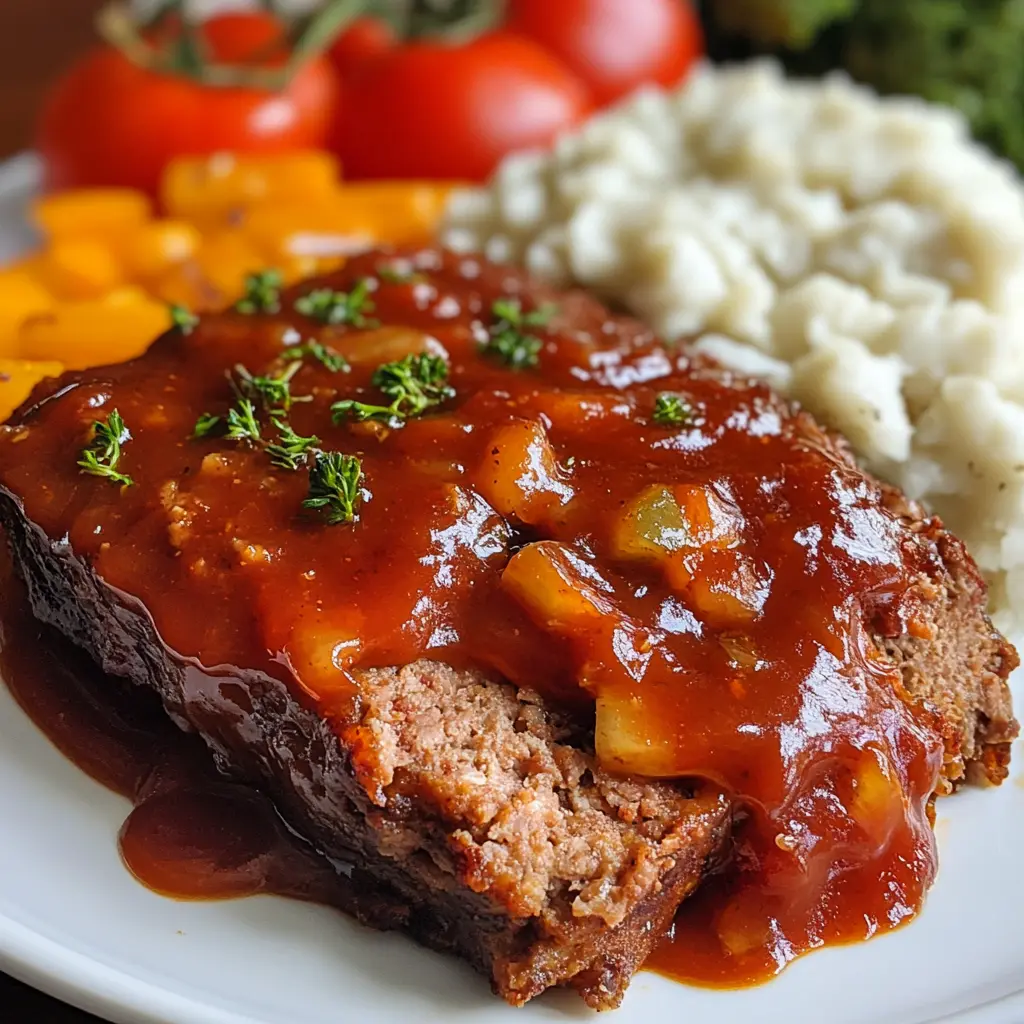Meatloaf is a timeless classic that has graced dinner tables for generations, but the real secret to making this dish extraordinary lies in the sauce. A well-made meatloaf sauce transforms a simple meatloaf into a savory, rich, and flavorful dish that the whole family will love. In this guide, we’ll break down everything you need to know about creating the perfect meatloaf sauce, from traditional recipes to modern twists, and tips for pairing it with different types of meatloaf.
Why Meatloaf Sauce is Essential
While the meatloaf itself provides a rich, hearty flavor, the sauce elevates it to a new level. A well-balanced sauce adds sweetness, tanginess, and moisture to the meatloaf, enhancing its overall texture and taste. The right sauce can turn a simple comfort dish into a gourmet meal.
There are many variations of meatloaf sauces, but most combine a base of ketchup, brown sugar, and vinegar, along with spices and seasonings for added depth. This sauce not only enhances the flavor but also keeps the meatloaf moist and adds a glossy, caramelized finish on top.
Classic Meatloaf Sauce Recipe

Let’s start with a traditional meatloaf sauce that’s simple yet packed with flavor. This recipe combines basic pantry ingredients for a tangy and sweet glaze that complements the meat perfectly.
Ingredients:
- 1/2 cup ketchup
- 1/4 cup brown sugar
- 1 tablespoon Dijon mustard
- 1 tablespoon Worcestershire sauce
- 1 teaspoon apple cider vinegar
- 1/2 teaspoon garlic powder
- 1/2 teaspoon onion powder
- A pinch of salt and pepper
Instructions:
- Mix the Ingredients: In a medium-sized bowl, combine the ketchup, brown sugar, Dijon mustard, Worcestershire sauce, apple cider vinegar, garlic powder, onion powder, salt, and pepper.
- Whisk Together: Whisk the ingredients until they’re fully combined, forming a smooth sauce.
- Apply the Sauce: Spread half of the sauce on top of the meatloaf before baking, and save the other half for glazing during the last 10 minutes of cooking.
- Bake: Bake the meatloaf as per your recipe’s instructions. Typically, this takes about 60 minutes at 350°F (175°C).
- Finish with Glaze: During the last 10 minutes of baking, brush the remaining sauce over the meatloaf to create a glossy, flavorful finish.
Why This Works
The combination of sweet and tangy flavors from the ketchup and brown sugar, along with the umami depth from the Worcestershire sauce and Dijon mustard, creates a balanced sauce. It complements the meatloaf’s savory, rich flavors without overpowering them. Adding the sauce in stages allows the flavors to penetrate the meatloaf while also providing a beautiful caramelized finish.
Variations of Meatloaf Sauce
If you want to take your meatloaf sauce to the next level, or simply experiment with new flavors, here are some popular variations that can give your dish a unique twist:
BBQ Meatloaf Sauce
For a smoky, tangy twist, try making a BBQ meatloaf sauce. This version adds barbecue sauce to the traditional ketchup base, along with a hint of spice.
Ingredients:
- 1/4 cup ketchup
- 1/4 cup barbecue sauce
- 1 tablespoon brown sugar
- 1 teaspoon smoked paprika
- 1 teaspoon garlic powder
- 1 tablespoon apple cider vinegar
Instructions:
- Mix all ingredients in a bowl.
- Follow the same application process as the classic recipe, adding half before baking and glazing with the rest at the end.
Honey Mustard Meatloaf Sauce
If you’re looking for something with a bit of sweetness and a tangy bite, honey mustard sauce is an excellent option. It’s a great way to lighten up the traditional recipe.
Ingredients:
- 1/4 cup Dijon mustard
- 2 tablespoons honey
- 1/4 cup ketchup
- 1 tablespoon apple cider vinegar
Instructions:
- Whisk all the ingredients together until well-combined.
- Apply to the meatloaf in the same two-step method as the classic sauce.
Spicy Meatloaf Sauce
For those who like a bit of heat, a spicy meatloaf sauce can be a fun and flavorful option. This sauce includes hot sauce or chili flakes for an added kick.
Ingredients:
- 1/2 cup ketchup
- 1/4 cup brown sugar
- 1 tablespoon hot sauce (like Sriracha or Tabasco)
- 1 teaspoon crushed red pepper flakes
Instructions:
- Combine all ingredients in a bowl.
- Apply as you would the classic sauce, layering it before and after baking.
How to Choose the Right Meatloaf Sauce for Your Dish
Choosing the right sauce depends on the type of meatloaf you’re making and your personal flavor preferences. Here are some pairing suggestions:
- Traditional Beef Meatloaf: The classic ketchup-based sauce works perfectly with beef meatloaf. Its balance of sweet and tangy flavors complements the richness of the meat.
- Turkey Meatloaf: A honey mustard or spicy sauce can add much-needed moisture and flavor to lean turkey meatloaf.
- Pork or Mixed-Meat Meatloaf: BBQ sauce or a smoky variant pairs well with pork or mixed meats, enhancing the savory, fatty elements of the dish.
- Vegetarian Meatloaf: For a vegetarian or lentil-based meatloaf, a tangy honey mustard or even a tomato-based sauce with herbs can add depth and flavor without overpowering the dish.
Tips for Perfecting Your Meatloaf Sauce
Creating the perfect meatloaf sauce is all about balance and technique. Here are some tips to ensure you get the most out of your sauce:
1. Don’t Over-Sweeten
While it’s tempting to add a lot of sugar to your sauce, especially in a ketchup-based recipe, too much sweetness can overwhelm the savory meatloaf. Stick to the recommended amounts and adjust to taste.
2. Layer the Sauce
Applying the sauce in stages allows the flavors to permeate the meatloaf without burning or becoming too caramelized. Start by spreading half the sauce on the meatloaf before baking, and then add the remaining sauce during the last 10-15 minutes for a glossy finish.
3. Add a Touch of Spice
Even if you’re making a classic sauce, adding a dash of cayenne pepper or chili flakes can help enhance the depth of flavor without making the dish too spicy.
4. Use Fresh Ingredients
For the best flavor, use fresh garlic, onions, or herbs in your sauce. Fresh ingredients add complexity and a more robust taste compared to pre-packaged seasonings.
Meatloaf Sauce: Nutritional Information
Although sauces typically add flavor and moisture to meatloaf, they also contribute to the dish’s overall nutritional profile. Here’s a quick overview of the nutritional aspects of a classic meatloaf sauce:
- Calories: A typical serving of meatloaf sauce (about 2 tablespoons) contains around 70-90 calories, depending on the amount of sugar and ketchup used.
- Sugar Content: Since many sauces are ketchup and sugar-based, they can have between 7-12 grams of sugar per serving. Opting for lower-sugar ketchup or reducing the amount of brown sugar can help reduce the sugar content.
- Sodium: Meatloaf sauces are often high in sodium due to ingredients like ketchup, mustard, and Worcestershire sauce. Be mindful of this if you’re watching your salt intake.
How to Store Meatloaf Sauce
If you have leftover meatloaf sauce, or if you’re preparing it ahead of time, here are some storage tips to ensure it stays fresh:
Refrigeration:
Store any leftover sauce in an airtight container in the fridge for up to one week. Make sure to give it a good stir before using it again.
Freezing:
Meatloaf sauce can also be frozen for up to three months. To freeze, place the sauce in an airtight, freezer-safe container or zip-lock bag. Thaw it in the fridge overnight before using.
Common Mistakes to Avoid When Making Meatloaf Sauce
Even seasoned cooks can make a few missteps when preparing meatloaf sauce. Here are some common mistakes to avoid:
1. Adding Too Much Sauce
While it’s tempting to load your meatloaf with sauce, too much can result in a soggy texture. Stick to a balanced amount: half applied before baking and half applied towards the end.
2. Using Sauce with High Sugar Content
Many store-bought sauces are loaded with sugar, which can cause the top of the meatloaf to burn before it’s fully cooked. If you’re using store-bought sauces, be mindful of the sugar content, or try making your own to control the sweetness.
3. Not Letting the Sauce Rest
After baking, let the meatloaf rest for at least 10 minutes before slicing. This allows the sauce to set, making it easier to cut and ensuring the flavors meld properly.
Conclusion: Perfecting Your Meatloaf with the Right Sauce
Whether you’re sticking to a traditional recipe or experimenting with new flavors, the sauce you choose can make or break your meatloaf. By following the tips and recipes in this guide, you’ll be well on your way to creating a delicious, flavorful meatloaf sauce that enhances the dish and leaves everyone asking for seconds.

